Plant Positive Products
Significant Yield Increase for an Investment of 5/acre
the science behind biowash
back to science class to appreciate BioWash's properties
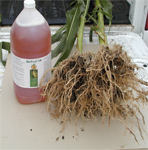
BioWash as an Adjuvant, Translocation Promoter, and Cationic Exchange Stimulator
Overview of Processes within the Plant
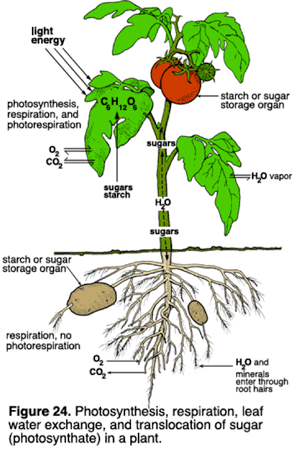
Photosynthesis is the primary driver of the plant. Through a series of complex steps, the plant extracts energy from sunlight to metabolize starches, cellulose, waxes, carbohydrates, oils, and proteins. Specialized photosynthetic cells called chloroplasts found in the leaves of the plant are the structures that accomplish this remarkable feat. One would be hard pressed to refute that accelerated photosynthesis would also lead to increased production of these essential plant nutrients. Other processes such as the transport of nutrient inputs and outputs such as sugar into the photosynthetic cycle and absorption of nutrients by the roots and leaves are also critical to a healthy, efficient plant. Through the use of colloidal micelles, the sciences of physics, chemistry, biology, and technology are uniquely combined to manufacture BioWash. Studies have shown that this technology used to manufacture BioWash gives BioWash a unique ability to substantially influence these critical cyclical processes. The unique properties of BioWash also allow it to exhibit adjuvant as well as translocation enhancer properties. The following discussion is a condensation/synthesis of many biological concepts and principles that will briefly explain how the properties of BioWash work in conjunction with naturally occurring plant processes to enhance plant growth and yield.
Interconnection of Plant Processes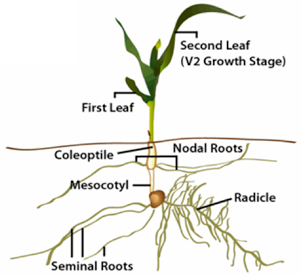
The diagram above illustrates the typical root development of a corn plant. The diagram below illustrates the processes that occur with the associated structures. The germinating seed produces a radicle (seminal root system) with lateral roots and hairs. Shortly thereafter the nodal (secondary) root system develops. Within the root, there are specialized structures called xylem and phloem. The function of the xylem (act like capillary tubes) is to conduct solutes (water + dissolved substances) from the root to the shoot. Thus, the mass flow of nutrients is from the roots to shoots. Osmosis explains how the water moves. The direction is from a higher concentration of water to a lower. Thus, water will be “drawn” to the solution that contains more dissolved solutes. The vertical transport of nutrients via the xylem accomplishes this by a combination of the processes of transpiration and osmosis. Transpiration occurs at the leaves. The plant actively loses water through pores at the surface drawing the water upwards. Essential nutrients extracted from the soil are transported to sites of growth and production in the shoot. The phloem is tubal structures that transport soluble food materials from the shoot (leaves) to the roots. The predominant substance transported in the phloem is sugar. The leaf captures energy from light (photosynthesis) and stores it as sugars and starches. The products are then transported by the phloem to the roots. Most leaves have a thick (usually shiny) waxy layer on the surface of the leaf that helps to control water loss in the plant. The structure that controls water loss is specialized openings (stomata) located on the underside of the leaves.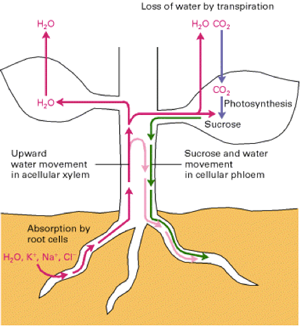
Action of BioWash through Roots (Cationic Exchange)
Cationic exchange is a process carried out by the root system of any plant to extract nutrients from the soil for the plant to use in photosynthesis and other plant functions. When applied to the root zone (in furrow application) BioWash, through this quantum physics/chemistry technology in its preparation, acts to stimulate new growth and development of the root system. It dissolves NPK (nitrogen, phosphate, potash) from the soil into very small units called colloidal micelles allowing expedited nutrient uptake into the plant. Nutrient uptake is further enhanced by the inclusion of sodium within the BioWash formulation. As discussed by Dr. Ted Tidwell in the Science of BioWash. BioWash contains minute amounts of the cation (positive charged) sodium. The surrounding negative charged ions (anions) attach themselves to the positive charges and are transported throughout the plant. The reason for this improved nutrient effect is the extremely small size of the colloid micelles. When these micelles enter the roots, they create a maximized environment for accelerated nutrient absorption and efficient uptake of water. Since less energy is required to uptake nutrients and water, that surplus energy may be used in transport of nutrients to the shoot. When these nutrients are expedited to the leaves, photosynthetic activity produces more products faster for transport to areas of the plant like the roots that are non-photosynthetic. BioWash enhances the efficiencies within and between these reciprocal processes. Thus, the early establishment of a vigorous root system is a critical component for healthy and viable plant development. The following diagrams illustrate the structures and principles discussed. 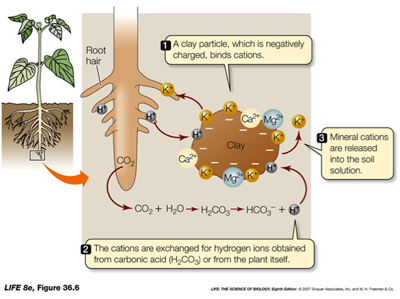
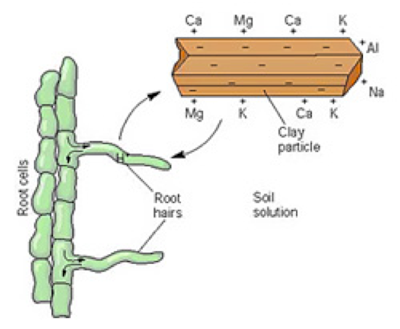
Action of BioWash as a Translocation Promoter
Within the plant, the movement of water and minerals is accomplished through the xylem and is driven by negative pressures. The movement of dissolved nutrients, predominantly sugars, is accomplished through the phloem and is driven by positive hydrostatic pressures. This process is termed translocation (refer to the diagrams below). Translocation is the movement of materials from leaves to other tissues throughout the plant. Plants produce sugars in their leaves by photosynthesis, but non-photosynthetic parts of the plant also require sugars and other organic and nonorganic materials for growth. For this reason, nutrients are translocated (transported) from sources (regions of excess sugars, primarily mature leaves) to sinks (regions where the sugars are needed). Some important sinks are roots, flowers, fruits, stems, and developing leaves. Leaves change roles during the growth of a plant because they are sinks when they are young and become sources later, when they are about half grown. When sugar is concentrated inside cells, water enters the cells by osmosis. Since the plant cells have a rigid cell wall, this influx of water creates a great deal of internal pressure. The pressure causes these dissolved substances to move out through the pores of the sieve element and down the phloem tubes. At the other end of the transport stream, in the sinks, sugar is constantly leaving the phloem and being used by surrounding cells. Some is consumed as an energy source, some is stored as sugar or starch, and some is used to make new cells if the sink tissue is growing. Since sugar leaves the phloem in the sink, water exits too (again by osmosis) and the pressure goes down. Therefore, there is a difference in pressure between source and sink phloem. This causes the solution to flow, just as water flows along a pressure gradient (high to low) in a garden hose. This process is known as the pressure-flow mechanism. One can now understand how BioWash would aid in this flow. Since the nutrients are packaged into much smaller units, there can be a higher concentration of materials available within the transport solution. Thus, BioWash plays a dual role by increasing absorbability of nutrients from the soil accompanied by accelerated transport of higher concentrations within the plant xylem and phloem systems. 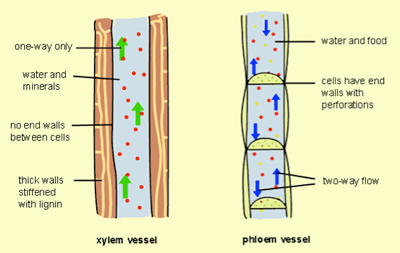

Action of BioWash in Foliar Feeding
Although the roots provide the bulk of the nutrition for the plant, foliar nutrition at different stages of a plant's life have proven to be effective. There have been numerous research pieces in many farm magazines and commercial manufacturers' literature on the effectiveness of micronutrient applications particularly when deficiencies exist in the soil profile. These foliar applications are usually formulated to be readily used by the plant at specific vegetative stages. To be absorbed through the leaves it requires the nutrients to be in a more absorbable form. Maximizing the absorption of these products via the leaves has been demonstrated by BioWash in several different crops. The explanation of how BioWash accomplishes this is discussed in the following paragraph. In manufacturing BioWash, extracts of natural plants are processed to form a homogeneous emulsion containing extremely small particles. These particles are classified as colloidal micelles. The micelle's small particle size (nanometers down to eight angstroms in size) combined with its extremely high surface area-to-volume ratio, enable it to penetrate complex carbon molecules and emulsify organic matter. BioWash acts like an adjuvant "packaging" the foliar nutrient in a highly absorbable state. Since the leaves have a waxy layer, BioWash in a diluted water solution, drastically reduces surface tension on the leaf surface and works as a dispersing agent that carries other active ingredients such as zinc, potassium, manganese, and boron more effectively than common surfactants. In this manner, BioWash can act as a surfactant to increase the absorption of foliar products. Increased absorbability results in more beneficial product that is available to the plant. Temperature during application of foliar products is an important consideration. It is also essential that the ambient air temperature falls below that of the ground temperature for the stomata to open. That is the optimal time for the stomata to be susceptible and amenable to the uptake of fluids and nourishment. The colloidal micelles formed by BioWash allow these particles to easily enter the stomata of the leaves where the plant can more directly accept their beneficial effect. High temperatures (usually >900 F) will signal the plant to go into "protective mode" (stomata will close to conserve water) and absorbability of nutrients would be compromised. The following diagram illustrates the structures previously discussed that involved in the absorption of nutrients through the leaves and the subsequent rapid movement into the transport systems of the plant.
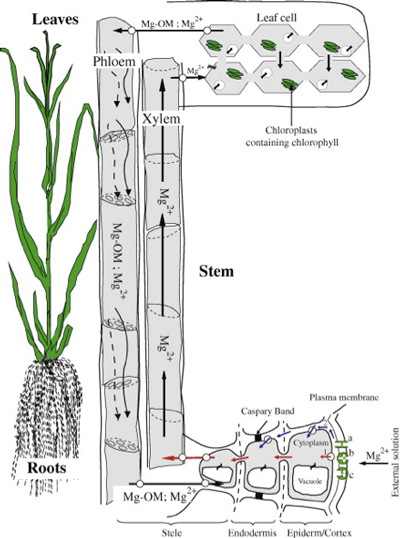
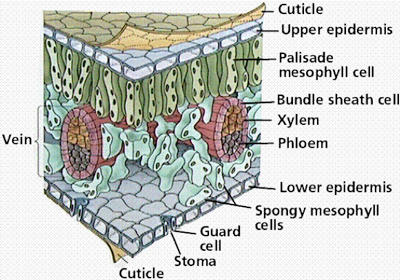
Stomata are openings on the underside of the leaf that respond to temperature changes. Cuticle is the waxy outer layer located on the upper surface of the leaf.
To copy Multiple Effects of BioWash pdf